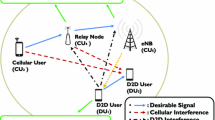Abstract
Device-to-device (D2D) communications underlaying LTE-advanced have proven to be efficient in improving network performance and offloading the traffic of the base station. Through sharing radio resources with cellular users (CUs), D2D communications can significantly enhance the overall spectral efficiency. In this paper, we propose a distributed cooperative D2D transmission scheme to improve the overall system throughput without deteriorating the quality of service of CUs. With cognitive capability, D2D users sense the cellular transmission and switch between the concurrent and cooperation modes in a decentralized way. In particular, D2D users transmit concurrently with the CUs during the initial cellular transmission timeslot, while D2D transmitters serve as relays to compensate for the degradation to the cellular transmissions in the cellular retransmission timeslot, referred to as cooperation mode. Two types of cooperation are exploited to improve the network performance: cooperation between CU and D2D pairs, and cooperation among D2D pairs. We derive exact closed-form expressions of both cellular throughput and D2D throughput over Rayleigh fading channels, and give the analysis of the network energy efficiency. Simulation results validate the theoretical analysis and show the superiority of the proposed scheme.







Similar content being viewed by others
Notes
It is worth noting that the proposed scheme applies to both uplink and downlink spectrum sharing. In this paper, we use the uplink spectrum sharing as an example.
It is worth noting that the proposed scheme and the analysis are applicable to any number of D2D pairs with arbitrary link lengths. However, as the complexity of the analysis increases with the number of D2D pairs, we consider a three-link scenario in our simulation to evaluate the network performance.
References
Yu, C.-H., Doppler, K., Ribeiro, C., & Tirkkonen, O. (2011). Resource sharing optimization for device-to-device communication underlaying cellular networks. IEEE Transactions on Wireless Communications, 10(8), 2752–2763.
Feng, D., Lu, L., Yuan-Wu, Y., Ye Li, G., Li, S., & Feng, G. (2014). Device-to-device communications in cellular networks. IEEE Communications Magazine, 52(4), 49–55.
Sun, H., Wildemeersch, M., Sheng, M., & Quek, T. Q. S. (2014). D2D enhanced heterogeneous cellular networks with dynamic TDD. CoRR, abs/1406.2752.
Lei, L., Zhong, Z., Lin, C., & Shen, X. (2012). Operator controlled device-to-device communications in LTE-advanced networks. IEEE Communications Magazine, 19(3), 96–104.
Doppler, K., Rinne, M., Wijting, C., Ribeiro, C., & Hugl, K. (2009). Device-to-device communication as an underlay to LTE-advanced networks. IEEE Communications Magazine, 47(12), 42–49.
Yu, C.-H., Tirkkonen, O., Doppler, K., & Ribeiro, C. (2009). Power optimization of device-to-device communication underlaying cellular communication. In Proceedings of IIEEE international conference on communications, 2009. ICC'09 (pp. 1–5).
Janis, P., Koivunen, V., Ribeiro, C., Korhonen, J., Doppler, K. & Hugl, K. (2009). Interference-aware resource allocation for device-to-device radio underlaying cellular networks. In Proceedings of vehicular technology conference, 2009. VTC Spring 2009 (pp. 1–5).
Zulhasnine, M., Huang, C., & Srinivasan, A. (2010). Efficient resource allocation for device-to-device communication underlaying LTE network. In Proceedings of 2010 IEEE 6th international conference on wireless and mobile computing, networking and communications (WiMob) (pp. 368–375).
Xu, C., Song, L., Han, Z., Zhao, Q., Wang, X., Cheng, X., et al. (2013). Efficiency resource allocation for device-to-device underlay communication systems: A reverse iterative combinatorial auction based approach. IEEE Journal on Selected Areas in Communications, 31(9), 348–358.
Sun, H., Sheng, M., Wang, X., Zhang, Y., Liu, J. & Wang, K. (2013). Resource allocation for maximizing the device-to-device communications underlaying LTE-advanced networks. In Proceedings of 2013 IEEE/CIC international conference on communications in China-Workshops (CIC/ICCC) (pp. 60–64).
Feng, D., Lu, L., Yuan-Wu, Y., Li, G., Feng, G., & Li, S. (2013). Device-to-device communications underlaying cellular networks. IEEE Transactions on Communications, 61(8), 541–3551.
Haykin, S. (2005). Cognitive radio: Brain-empowered wireless communications. IEEE Journal on Selected Areas in Communications, 23(2), 201–220.
Goldsmith, A., Jafar, S. A., Maric, I., & Srinivasa, S. (2009). Breaking spectrum gridlock with cognitive radios: An information theoretic perspective. Proceedings of the IEEE, 97(5), 894–914.
Li, Q., Ting, S. H., Pandharipande, A., & Motani, M. (2012). Cooperate-and-access spectrum sharing with ARQ-based primary systems. IEEE Transactions on Communications, 60(10), 2861–2871.
Tannious, R., & Nosratinia, A. (2010). Cognitive radio protocols based on exploiting hybrid ARQ retransmission. IEEE Transactions on Wireless Communications, 9(9), 2833–2841.
Ericsson (2007). R1–070472: Uplink control signaling-summary of e-mail discussions. In 3GPP TSG RAN WG1 Meeting 47.
Su, H., & Zhang, X. (2008). Cross-layer based opportunistic mac protocols for Qos provisionings over cognitive radio wireless networks. IEEE Journal on Selected Areas in Communications, 26(1), 118–129.
Acknowledgments
This work is supported in part by National Natural Science Foundation of China under Grant 61231008, 61172079, 61201141, 61301176, and 91338114, by the National High Technology Research and Development Program of China (863 Program) under Grant 2014AA01A701, by the 111 Project under Grant B08038.
Author information
Authors and Affiliations
Corresponding author
Rights and permissions
About this article
Cite this article
Sun, H., Sheng, M., Wang, X. et al. Distributed cooperative device-to-device transmissions underlaying cellular networks. Wireless Netw 21, 1411–1423 (2015). https://doi.org/10.1007/s11276-014-0875-y
Published:
Issue Date:
DOI: https://doi.org/10.1007/s11276-014-0875-y




